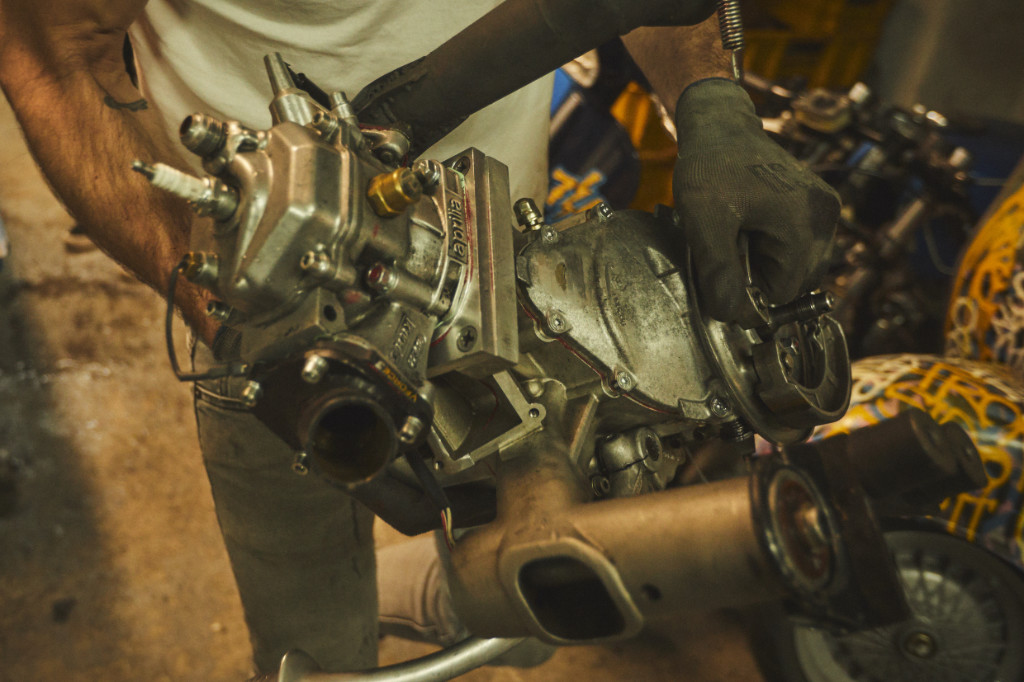For many motorcyclists, the question of whether to use a two-stroke or a four-stroke engine in a Vespa has become a question of faith. In earlier decades, only two-stroke engines left the famous factory in Pontederra. The decisive factor for this was the initial situation in 1946, the year in which the first Vespa was manufactured. As a result of the war, raw materials were scarce and an inexpensive and simple engine had to be created. So it was obvious to use the two-stroke engine with its advantages. In the newer models, the focus is mainly on ultra-modern 4-stroke engines, although engines with two strokes are still supplied today.
Mode of operation decisive for naming
The name of the two fundamentally different engine types is based on the way they work. In the 2-stroke engine, every second stroke is a so-called power stroke, with which energy is generated. With the 4-stroke, logically, this is only every fourth stroke.
In a two-stroke engine, the piston moves from bottom to top during the first stroke. The upper part of the cylinder contains the mixture of oil and fuel mixed with air. The upward movement of the piston compresses the mixture. This mixture is then ignited at the uppermost point by the spark plug, which is always screwed into the cylinder cover on Vespas. The second stroke now follows immediately. The combustion of the mixture causes it to expand and pushes the piston back down to the starting point, the so-called dead centre. This generates mechanical energy, which provides the drive to the Vespa. When the piston moves downwards, the exhaust gases produced are released and at the same time fresh mixture is drawn in again.
In a four-stroke engine, this basically similar process is divided into four steps. In the first step, the piston starts at the top, i.e. at top dead centre, and draws fresh mixture into the cylinder by moving downwards. In the second stroke, the mixture is strongly compressed and ignited by the spark plug in the cylinder head. In the following stroke, the decisive stroke is completed. Here the mixture burns and the piston is pushed down. In the final stroke, the piston is again pushed upwards from below. In the course of this, the exhaust gases are pushed out before the process starts again.
Essential differences between the types
While the technical part was described in the previous section, the practical effects of each engine type will now be described.
Lubrication, which makes the movement of the piston in the cylinder possible in the first place, is provided by fresh oil in the two-stroke. The old Vespa models before the turn of the millennium relied almost exclusively on mixed lubrication. For this, a proportion of 2-5% oil had to be added directly to the petrol in the tank. This is described by the mixing ratios 1:20 or 1:50. In the more modern two-stroke models, lubrication is carried out separately. An external oil tank meters the required amount of oil and feeds it to the cylinder by means of a pump.
In four-stroke engines, lubrication is not provided by fresh oil. The oil must be supplied separately and changed at regular intervals due to wear.
Advantages and disadvantages
As in almost every area of life, there are certain advantages and disadvantages to both types of engine, which makes the question raised at the beginning regarding the type a real question of faith.
Advantages and disadvantages of two-strokes:
A very significant advantage of the two-stroke is the often praised lively pull. This is due to the fact that every second stroke generates mechanical energy and thus, to put it simply, twice as much work is done. Therefore, the two-stroke engine responds more quickly during acceleration. In addition, the two-stroke engine is also simpler in design and therefore less expensive. It is also easier for Vespa mechanics to maintain and, if necessary, tune a two-stroke engine themselves.
For many, a significant disadvantage is the increased oil or fuel consumption that comes from adding fresh oil. In addition, the exhaust fumes and noise of a two-stroke are much more disturbing than those of a four-stroke.
Advantages and disadvantages of four-strokes:
Longevity is an argument that is always closely associated with a four-stroke, and rightly so. Combustion via the controlled valves also emits significantly fewer exhaust gases. The slower mode of operation also means that no such loud noise is developed, which explains the quieter and more muffled sound of the four-stroke. In addition, fuel consumption is significantly lower, which means lower running costs.
However, due to the more complex construction of the type, the purchase costs are sometimes also significantly higher.
Both variants have their raison d’être – even today – and create so many possibilities for different situations. While one Vespa rider likes to start with a throaty sound and a blue cloud of unburnt oil, others like to start quietly and relaxed. All in all, it is and remains a matter of taste which type suits you better. Many years from now, there will still be heated discussions about this at rides and regulars’ tables.




Comments (2)